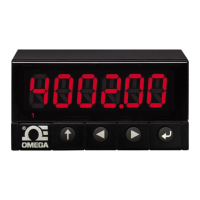PLATINUM
TM
Series Meters Quick Start Guide
1.
Introduction
This PLATINUM
TM
Series Meters Quick Start Guide provides only a brief overview of each controller’s
functions and quick configurations to get started. Please refer to the PLATINUM
TM
Series Meters User’s
Guide PDF at Omega.com/manuals for complete information and specifications for each end device.
1.1 Description
The PLATINUM
TM
Series meter offers unparalleled flexibility in process measurement. While the meter is
extremely powerful and versatile, great care has gone into designing a product that is easy to set up and
use. Automatic hardware configuration recognition eliminates the need for jumpers. The PLATINUM
TM
Series meter displays only the menu items associated with the system’s custom configuration.
Each unit allows the user to select the input type from 9 thermocouple types (J, K, T, E, R, S, B, C, and N),
Pt RTDs (100, 500, or 1000 Ω, with a 385, 392, or 3916 curve), thermistors (2250 Ω, 5K Ω, and 10K Ω), DC
voltage, or DC current. The analog voltage inputs may be single ended bipolar, differential absolute or
differential ratiometric and both voltage and current are fully scalable using a single point or 10-point
linearization to virtually all engineering units with a selectable decimal point that is perfect for use with
pressure, flow, or other process inputs. Multiple Alarms can be configured for above, below, hi/lo, and
band triggering using either absolute or deviation Alarm trigger points.
The PLATINUM
TM
Series meter features a large, three-color, programmable display with the capability to
change color every time the Alarm is triggered. Various configurations of mechanical relay, SSR, DC
pulse, and isolated or non-isolated analog voltage or current outputs are available. Every unit comes
standard with USB communications for firmware updates, configuration management, and data
transfer. Optional Ethernet and RS-232 / RS-485 Serial communications are also available. The Analog
Output is fully scalable and may be configured for retransmission to follow your input signal. The
universal power supply accepts 90–240 Vac. The low-voltage power option accepts 24 Vac or 12–36 Vdc.
Additional features usually found only on more expensive meters make these the most powerful
products in their class. Some additional standard features are High-high/Low-low Alarm functionality,
external latch reset, configuration save and transfer, and configuration password protection.

